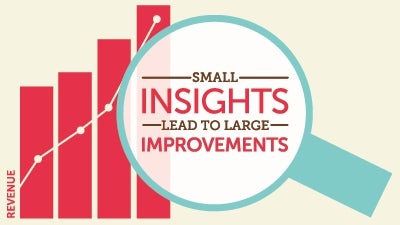Home > Leadership > Strategic Planning >
Get Out of Startup Mode and Transform Your Business with Data
By: Amber Bezahler

Many small businesses continue to function as startups years after their inception. They struggle to meet their financial projections and don’t believe they have the personnel or the time to invest in developing a long-term strategy.
Pausing from day-to-day operations to articulate a long-term vision and define metrics for success can help any small business reach its true potential. Even if your company has as few as five employees, data can provide insights that lead to huge organizational improvements and, most importantly, prevent you from making critical mistakes.
Working data into the DNA of your company may seem like a daunting task, and it’s easy to waste resources on ineffective analysis. However, with a little bit of patience and the right guidance, you can be up and running in a matter of weeks, and you’ll quickly find yourself looking at your business in a whole new way as you uncover areas of weakness, as well as potential opportunities for growth.
Here’s how to get started:
1. Get Your Systems in Place
To begin gathering data, the first tool you need is an analytics platform like Google Analytics. Powerful and free, Google Analytics will help you learn what sources are bringing leads to your website, how long visitors stay, which pages they visit, where they get stuck and leave, which other businesses they visit, as well as a host of other useful info.
Next, every small business should have a customer relationship management system to manage interactions with customers, track leads and sales, and automate functions like marketing and customer service. According to Emergent Research, only 14 to 18 percent of small businesses use CRM systems, but this is a mistake. A CRM system is the most cost-effective way to gain a better understanding of your customers and business.
Third, if you’re using social media—and you should be—there are some great inexpensive resources, such as Sprout Social, for monitoring these channels. If you can’t work this into your initial budget, try it at a later date.
2. Not All Numbers Are Equally Important
To reach your goals, you need to first determine which metrics are the most important to your business. There’s a huge difference between data that’s merely interesting and key performance indicators. KPIs are metrics that are both meaningful and actionable.
The two most frequent mistakes organizations make when measuring data are gathering too much data and organizing or presenting it in an unintelligible way. To get the most out of your CRM, develop a list of the core insights you’d like to glean from your customers and marketing programs. Then, make sure your system can be configured to provide answers. These questions might include:
- How many leads do I get each day?
- Where are they coming from?
- How many of these leads are quality prospects?
- What did each quality prospect cost?
- How many sales did we make this month?
- From which geographic areas do our best customers come?
- What is the estimated lifetime value of each customer?
3. Metrics Are a Team Sport
It’s not enough for you to understand the power of numbers. That understanding must be spread to every team member. Take the time to establish metrics that everyone can understand, and explain how those numbers reflect real business goals. Running a business is about much more than numbers, but everyone should care about what those numbers signify.
4. It’s Better to Learn From Others’ Mistakes
If you can, bring in an expert who can guide you through this process. Small businesses commonly lack personnel who are sufficiently versed in the customer experience and sufficiently tech savvy to research, vet, and select the best and most cost-effective tools to move your business forward. An expert can help you define essential metrics, select tools that best fit your organization, and effectively communicate new strategies to your team.
In sum, the right metrics can show you how your business is performing in real time and reveal areas that can boost your bottom line. The key is to focus on actionable metrics and empower your employees with an understanding of the numbers and the insights they reveal.
Do you plan on building data into your business in 2015? What are you hoping to learn?
Published: October 31, 2014
4336 Views
4336 Views











